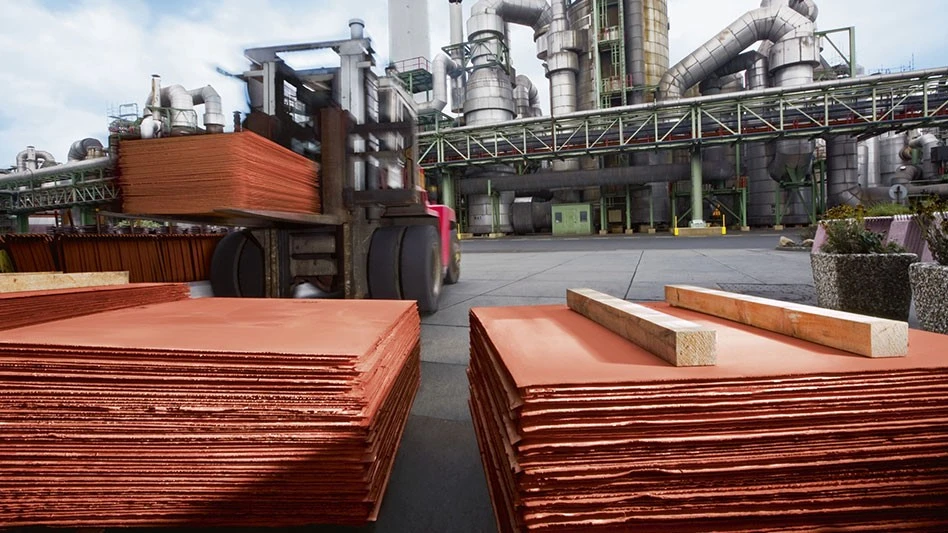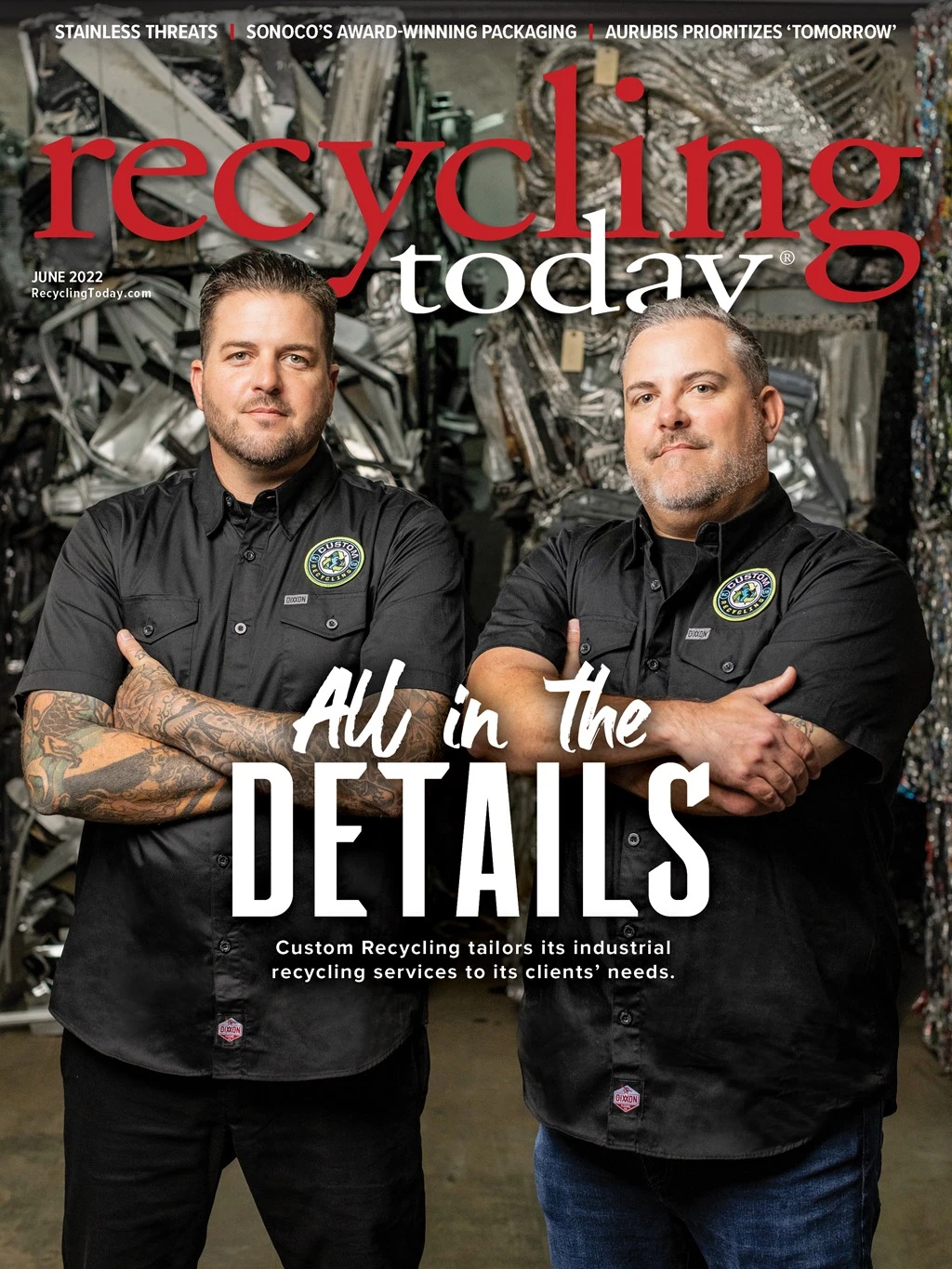
Photo courtesy of Aurubis


Aurubis AG, founded in 1866, is leading global provider of nonferrous metals and one of the largest copper recyclers worldwide. The company’s CEO, Roland Harings, refers to Aurubis as “the most sustainable smelter network in the world,” adding that it is committed to delivering more value with less environmental impact through its Tomorrow Metals by Aurubis product label.
“Our commitment encompasses our many efforts to act and do business sustainably, efforts we have already made in the past and will continue to push forward in the future as well,” he says. “Those who buy from Aurubis today and in the future can be assured that our metals are at the forefront when it comes to their environmental footprint.”
Harings adds, “Sustainability is a fundamental part of the Aurubis strategy. ‘Aurubis responsibly transforms raw materials into value’—following this maxim, we integrate sustainable conduct and business activities into the corporate culture. This involves a careful approach to natural resources, responsible social and ecological conduct in everyday business and sensible, healthy growth.”
The company seeks to achieve carbon-neutral production well before 2050, with Harings saying Aurubis is well on its way to meeting this goal. “Within just six years, the carbon footprint of cathode copper from Aurubis has decreased by a full 25 percent. And even before that, the carbon footprint of our cathode copper was a full 40 percent below the global average for all copper smelters and refiners,” he adds.
In November of last year, Aurubis announced an investment of $346.5 million in the U.S. that will help it further its sustainable production goals. Aurubis Richmond, to be built in Augusta, Georgia, in Richmond County, will be the company’s first secondary smelter in the U.S. Construction is scheduled to begin this summer, and commissioning is expected to begin in the first half of 2024.

Addressing a need
Harings says Aurubis is investing to build a secondary smelter in the U.S. for many reasons. “First of all, the need for modern, sustainable, local processing capacities in the U.S. is very strong,” he says. “Today, the available capacities aren’t at all sufficient to cover the high demand, so large volumes of valuable feed materials have to be exported. And here Aurubis comes into play: With the new capacities, we’re in a strong starting position at the right time and are receiving enthusiastic local support due to the investment’s sustainability aspects, especially, for which I’d already like to express my sincerest thanks.”
He says the site is the first secondary smelter for multimetal recycling in the United States. It will process approximately 90,000 metric tons of circuit boards, copper cable and other recyclables that contain metals to produce 35,000 metric tons of blister copper annually. “We will further process the intermediate products into various industrial and precious metals at our European smelter sites to a great extent but also [will] sell them directly in the U.S. market,” Harings says.
The addition of the secondary smelter near Atlanta allows Aurubis to tap into a market with strong growth potential and expand its international integrated smelter network, he says.
Aurubis Richmond is expected to generate 80 million euros, or $83.4 million, in earnings before interest, taxes, depreciation and amortization (EBITDA) at full production capacity starting in fiscal year 2025-26, Harings adds.

He says the investment is an example of sustainable growth, positioning the facility to become “a forerunner for multimetal recycling in the U.S.,” a role the company already has in Europe.
The site that Aurubis has selected in Augusta offers many advantages, Harings says, including proximity to suppliers, availability of utilities, skilled workers and expansion options. “To transport the intermediate products to our European smelter sites by ship, the close proximity to the Port of Savannah played an important role in our decision.”
Harings says the company’s secondary smelter in Georgia will be similar to its other secondary smelters in terms of the input materials, adding, “Aurubis Richmond is a 100-percent-scrap-based operation converting scrap into copper blocks. Like in all other sites, we will implement the highest environmental, health and safety standards.”
The site will feature the latest, most efficient technology, he says.
The company has signed a contract with SMS Group of Dusseldorf, Germany, to develop the facility concept, deliver it and implement it on-site. The SMS Group also is delivering the technology for the top-blown rotary converter, which Aurubis describes as a state-of-the-art piece of equipment for processing complex recyclables to recover copper, nickel, tin, zinc, precious metals and platinum group metals. The scope of delivery also includes the sampling and off-gas cleaning facilities.

Scrap’s role
Aurubis has a 155-year history of processing complex metal concentrates, scrap metals, organic and inorganic metal-bearing recyclables and industrial residues, Harings says. “Aurubis produces more than 1 million tons of copper cathodes annually and from them a variety of products, such as wire rod, continuous cast shapes, profiles and flat-rolled products made of copper and copper alloys.”
In addition to copper, Aurubis produces precious metals, selenium, lead, nickel, tin and zinc, as well as sulfuric acid and iron silicate.
The company employs approximately 7,200 people at production sites in Europe and the U.S. and throughout its service and distribution system in Europe, Asia and North America. It operates two primary smelters in Hamburg and one in Pirdop, Bulgaria, which also process scrap. In Europe, Aurubis operates four secondary smelters in Lunen, Germany; Olen and Beerse, Belgium; and Berango, Spain. The company also has a production site in Buffalo, New York.
“We process copper concentrates that are obtained from ores and are offered by mining and trading companies on the global market,” Harings says. “Aurubis doesn’t hold any stakes in mines and has a globally diversified supplier portfolio.”

Additional raw materials range from copper scrap with very high copper content, which Harings says can be feed directly into the copper fabrication process, to stamping scrap containing precious metals and high levels of copper, alloyed scrap, slags from foundries and other industrial restudies.
He continues, “Additional products result from processing the elements that accompany copper in the feed materials, elements that are in some cases purchased on purpose as part of our multimetal approach. In particular, these include different metals, such as gold, silver, lead, nickel, tin, zinc; minor metals like tellurium and selenium; and platinum group metals.”
Aurubis sources most scrap for its secondary smelters from Europe and North America, Harings says. The company also uses high-content copper scrap for process management purposes in its Hamburg and Pirdop primary smelters.
He continues, “Metal trading companies are the main actors on the supply side for recycling materials, though some recycling materials also reach us directly from industry through our closing-the-loop approach.”
Aurubis’ copper scrap and blister copper inputs totaled 436,000 metric tons in fiscal year 2020/21, Harings says. “The input of other recycling materials, such as industrial residues, slimes, shredder materials and electrical and electronic scrap, was at 566,000 [metric tons]. This amounts to more than 1 million [metric tons] of scrap material.”

Strong and growing

The copper cathode, wire rod, continuous cast shapes, profiles and flat-rolled products Aurubis produces are in strong demand, Harings says, “which means that we are currently sold out until the end of the year and will only be able to serve new orders in the new year.”
This strong demand for copper and precious metals will be further supported by the growth in automation, digitalization, electrification and renewable energy production, he says.

With the global trend of sustainability, Harings says, “collecting and recovering mixed material waste will continue. This is a key development our business model at Aurubis Richmond in Georgia will benefit from: to recover copper from electric and electronic scrap.”
The investment in Atlanta is only one part of the company’s growth strategy. Aurubis also is investing nearly 30 million euros, or $31.6 million, in Beerse to construct a state-of-the-art recycling facility to process anode sludge, Harings says, while in Olen, it is constructing BOB, or bleed treatment Olen Beerse, facility for about 70 million euros, or $73.8 million, to increase nickel and copper recycling capacity.
“In addition, we are expanding our business into the growth area of battery recycling,” he says, mentioning the start of test operations at a new pilot plant at the company’s Hamburg headquarters. “In a hydrometallurgical process, we want to recover lithium, nickel, cobalt, manganese and graphite from black mass, a powdery residue from dismantling and shredding lithium-ion batteries. We plan to commission an industrial-scale battery recycling plant within the next five years.”
Harings adds, “The future is made from metals,” and the investments Aurubis is making are positioning the company to increase the circularity of these vital materials.

Explore the June 2022 Issue
Check out more from this issue and find your next story to read.
Latest from Recycling Today
- BMW Group, Encory launch 'direct recycling’ of batteries
- Loom Carbon, RTI International partner to scale textile recycling technology
- Goodwill Industries of West Michigan, American Glass Mosaics partner to divert glass from landfill
- CARI forms federal advocacy partnership
- Monthly packaging papers shipments down in November
- STEEL Act aims to enhance trade enforcement to prevent dumping of steel in the US
- San Francisco schools introduce compostable lunch trays
- Aduro graduates from Shell GameChanger program





